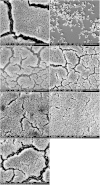Transcriptome analysis of the biofilm formed by methicillin-susceptible Staphylococcus aureus
- PMID: 26149474
- PMCID: PMC4493712
- DOI: 10.1038/srep11997
Transcriptome analysis of the biofilm formed by methicillin-susceptible Staphylococcus aureus
Abstract
Biofilm formation is regarded as one of the major determinants in the prevalence of methicillin-resistant Staphylococcus aureus (MRSA) as pathogens of medical device-related infection. However, methicillin-susceptible S. aureus (MSSA) can also form biofilm in vitro and such biofilms are resistant to vancomycin. Hence, researching the possible mechanisms of MSSA biofilm formation is urgent and necessary. Here, we used S. aureus ATCC25923 as the model strain, and studied gene expression profiles in biofilms after the treatment of ursolic acid and resveratrol using RNA-seq technology. The results showed that only ursolic acid could inhibit biofilm formation, which differed from their applied on the multiple clinical drugs resistant MRSA biofilm. RNA-seq data was validated by examining the expression of six genes involved in biofilm formation by qRT-PCR. These data analysis indicated that the mechanism of the MSSA biofilm formation was different from that of the MRSA, due to absence of accessory gene regulator (agr) function. These findings suggest that biofilms of S. aureus with agr dysfunction may be more resistant than those with agr function. Therefore, the infection from clinical MSSA may be recalcitrant once forming biofilm. Further study is necessary to uncover the mechanisms of biofilm formation in other clinical S. aureus.
Conflict of interest statement
The authors declare no competing financial interests.
Figures




References
-
- Nostro A. et al. Effects of oregano, carvacrol and thymol on Staphylococcus aureus and Staphylococcus epidermidis biofilms. J Med Microbiol 56, 519–523 (2007). - PubMed
-
- Kiran M. D. et al. Discovery of a quorum-sensing inhibitor of drug-resistant staphylococcal infections by structure-based virtual screening. Mol Pharmacol 73, 1578–1586 (2008). - PubMed
-
- Lowy F. D. Staphylococcus aureus infections. N Engl J Med 339, 520–532 (1998). - PubMed
-
- Wyatt M. A. et al. Staphylococcus aureus nonribosomal peptide secondary metabolites regulate virulence. Science 329, 294–296 (2010). - PubMed
Publication types
MeSH terms
Substances
LinkOut - more resources
Full Text Sources
Other Literature Sources
Medical
Molecular Biology Databases

